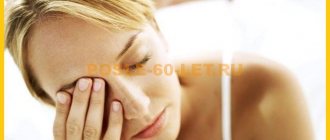The eyeball is an important part of the visual system, responsible for perceiving elements of the surrounding world. It consists of individual elements connected to the brain by nerve endings. All elements serve different purposes, but that doesn't make them any less important. Since the organs of vision are very sensitive to the effects of external irritants, people often go to doctors with complaints that their eyeball hurts inside. Various factors can contribute to this phenomenon, starting with inflammation or infectious diseases, and ending with mechanical damage to the organs of vision as a result of injuries.
The inside of the eyeball hurts
Types of pain
Since the eyeballs contain various nerve endings, the organs of vision are able to react sharply even to minor adverse effects , whether external or internal. The main task of pain receptors is to protect the eyes from negative influences. As a rule, external factors have a negative impact on the human visual organs throughout the entire time in the form of plant pollen, pathogenic microorganisms or dust.
The structure of the eyeball
If foreign agents affect the eyes too intensely, the nerve cells respond to this with increased tearing and pain. In this case, the eye gets rid of or makes attempts to eliminate the foreign object that is located in it. But internal factors can actually provoke the development of pain. There are many ophthalmological diseases and disorders that can cause pain in the eyeballs, thereby worsening the condition of the patient’s visual organs.
Nerves and blood vessels of the eye
There are several types of pain in the eyeball:
- internal or external;
- when working the eye muscles;
- upon palpation (with mechanical impact on the patient’s eyeballs);
- with hypobiosis.
Pain in the eyeball
On a note! As a rule, pain in the eyes is associated with banal fatigue caused by prolonged reading or working at the computer. But often such sensations arise with the development of serious pathologies, ignoring the symptoms of which can provoke the development of serious complications, including complete loss of vision.
What is dry eyes
Anatomy and functions of the eye
The eye is a paired organ, has a slightly anteriorly flattened shape, its walls consist of three membranes:
- External (fibrous).
It consists of the sclera (protein) and the cornea. The sclera maintains the shape of the eye, the cornea transmits and refracts rays.
- Middle vascular.
The choroid of the eyeball includes the iris, ciliary body and choroid.
- Inner - retina.
The retina functions as a visual receptor. Consists in close interaction with the choroid.
Also, anatomically, the eye consists of three transparent media:
- Intraocular fluid.
- Lens.
- Vitreous body.
The eyeballs are a kind of sensors with the help of which electromagnetic impulses are detected and a person sees objects at different times of the day. They are located in the skull in the eye sockets. The eyeballs have a wide network of blood vessels and nerve endings, making them very sensitive to pain. The eyes react sharply not only to pain associated directly with themselves, but also to various types of pain in other organs and systems.
A large number of nerve endings also helps to quickly respond to the slightest damage to the eyes - the entry of a foreign body, a change in temperature, harsh light. The impulses are quickly transmitted to the brain, and the eye immediately closes with the eyelid.
Why does it occur
The appearance of pain in the eyeballs can be associated with many factors. Let's look at the most common of them:
- severe eye fatigue . As a rule, overstrain of the eye muscles most often occurs among programmers or simply people working at a computer;
- long-term migraine . Scientists have found that a severe headache provokes tension and dilation of the eye vessels, which is why unpleasant sensations appear;
- development of an infectious disease affecting the organs of vision . Such pathologies are often accompanied by inflammation and pain in the eyes.
The occurrence of dry eye syndrome
It is worth noting that pathogenic microorganisms or various infections enter the patient’s eyes both from the external environment and as a result of the appearance of inflammatory foci in the patient’s body itself. For example, a patient who has had a history of sinusitis or sinusitis will most likely experience an eye infection.
Symptoms of sinusitis
Headache
The eyes hurt, as if they are pressing in tension headaches or cluster headaches.
Tension headaches develop due to excessive irritation of the optic nerve, stress, and psychological stress.
Compressive pain, spreading to both halves of the head, usually occurs in the absence of any organic lesion or disease. They are the nervous system's response to the following:
- working hard in a dimly lit room;
- exposure to very bright sunlight;
- hypothermia or overheating of the body;
- emotional experiences, both negative and positive;
- physical fatigue;
- taking medications that stimulate the central nervous system or increase intraocular pressure.
In addition to pressing pain in the eyes, tension headaches can radiate to the neck muscles, making bending the head forward painful.
A headache of this type is often one of the signs of chronic fatigue syndrome or nervous burnout of the body.
A person with such a nervous disorder constantly wants to sleep, he is apathetic and weakened, nausea appears, and pressing pain in the eyes. Episodes of drowsiness may be followed by insomnia. Nervous tension negatively affects the functioning of the cardiovascular system and gastrointestinal tract.
Pressing pain in the eyes can be caused by changes in atmospheric pressure
Many people also associate eye pain with fluctuations in atmospheric pressure and weather sensitivity. In some people, the eyes react so strongly to changes in pressure due to disruption of vascular regulation, so the decreased atmospheric pressure causes an increase in blood pressure.
Cluster headaches have a very pronounced pain syndrome in the projections of the brain onto the skull. This type of headache acquired its name due to the serial nature of attacks that occur one after another and then do not appear for a long time.
In this case, pain occurs behind one of the eyes, half of the face may swell, turn red, eyelid ptosis is noted, and sweating increases. Usually the pain affects only one eye, for example, the left, and in 90% of cases it does not change the direction of occurrence.
Diseases that cause pain
It was previously noted that various ophthalmological pathologies can provoke pain in the eyeball. As a rule, such diseases develop as a result of infection with pathogenic bacteria. Below are the most common pathologies that cause this symptom.
Table. Eye diseases that cause pain.
| Name of the disease | Description |
| Uveitis | A common ophthalmological disease accompanied by inflammation of the choroid of the organs of vision. The main symptom of the disease is the appearance of a veil or fog before the patient’s eyes. The patient may also experience pain in the eyeball or a feeling of heaviness. Incorrect treatment or its complete absence often leads to complete or partial blindness. |
| Glaucoma | A rather unpleasant disease of the organs of vision, in which the patient’s intraocular pressure increases. Its development may be indicated by symptoms such as decreased visual acuity, heaviness in the eyes, attacks of nausea and pain in the eyeballs. When trying to look at objects in bright light, circles appear before the patient's eyes. It is worth noting that with the development of glaucoma, an unusual feeling of the presence of a foreign body in the eye may occur. |
| Dry eye syndrome | An “occupational” disease of programmers, since this syndrome is most often encountered by people who spend a lot of time at the computer or are in a room where the air conditioner is constantly running. The occurrence of pain in the eyes is associated with impaired blood circulation in the eye vessels, as a result of which the eye tissues do not receive enough nutrients. Pathology can be diagnosed only by examining the patient’s vascular system. |
| Iridocyclitis | An eye disease that is accompanied by inflammation of the ciliary and iris bodies. Among all the symptoms, the most pronounced are photophobia and pain in the eyeball. The peculiarity of iridocyclitis is that during its course the patient’s intraocular pressure is within normal limits. |
| Optic nerve ischemia | A disease that develops against the background of deterioration of blood circulation in the ocular arteries that supply the retina. As a rule, the disease is accompanied by decreased visual acuity, the appearance of fog before the eyes, migraines and pain in the eyeballs. After physical exertion or overwork, some signs of pathology may intensify. |
Anterior ischemic neuroopticopathy: A – ophthalmoscopic picture of the fundus: severe swelling of the optic disc, microhemorrhages; B – hyperfluorescence of the optic nerve head during fluorescein angiography
On a note! Other reasons can also provoke the appearance of painful sensations in the eyeball, for example, traumatic damage to the organs of vision. The consequences of this phenomenon are very serious and without timely medical care, even a seemingly minor injury can lead to blindness.
Eye injury
Causes of eye pain and treatment
Why does the eyeball hurt? The occurrence of pain in the eyeball area has an external and internal cause. Appears in all organ conditions. Hypertension can increase the pressure in the eyeball, causing pain when pressing on it with a finger. Flu, increased body temperature, and runny nose have a negative impact.
Separately, it is worth noting the presence of tumors, which causes headaches and eyes. Nervous disorders, which in some people result in pain throughout the body, are not beneficial. The eyeball hurts due to vascular disease, ischemia. The pain goes away when the disease is cured, without ophthalmic surgery.
The main thing is to start treatment on time. This will avoid serious consequences, for example, loss of vision. Examinations performed by an ophthalmologist will help determine the causes of pain. Based on their results, treatment is prescribed.
Overwork
A common cause of eye pain is overworking of the eye muscles. The eyes hurt after hard work with papers, a computer, long reading, or watching TV. The eye muscles are poorly adapted to tension, so they need rest. A dull and aching pain appears, it hurts to blink, and he looks away to the side.
“Dry eye syndrome” occurs when working with a computer or being in an air-conditioned room. The reason is the drying out of the outer shell of the eye under the influence of external factors. Special ophthalmic drops help cure the disease. The main thing is to consult a doctor in time.
Incorrectly chosen glasses cause discomfort. Unpleasant sensations are caused by eye strain due to excessive magnification or, conversely, insufficient magnification of the lenses. The correct choice of glasses will help you overcome this difficulty. Consult an eye doctor to determine the correct glass size.
Contact lenses cause eye pain. Unpleasant sensations arise due to protein deposits or debris on the inner surface of the lens. It can be eliminated by replacing the solution with new lenses instead of old ones. A responsible approach is needed to selecting and wearing lenses so as not to introduce infection into the organs of vision.
Infection
The location of the eyes next to the nasal sinus opens the door to infection, such as tonsillitis and sinusitis. Due to the dense arrangement of nerve endings, the fundus of the eye hurts more than the rest of the eye. Inflammation severely affects nerve cells, pain occurs when moving the eyes. Painful symptoms, such as sharp, throbbing pain from the nose to the eyes.
Inflammation of the eyeball is caused by infectious diseases. Caries provokes the penetration of inflammation to the eyeball. Occasionally, herpes leads to inflammation of the trigeminal nerve, which is painful. Shingles leads to inflammation of the visual organs, resulting in loss of vision.
A common type of inflammation is conjunctivitis, characterized by itching, tearing, and purulence of the eyes. The disease is caused by microorganisms and an allergic reaction. Treated with eye drops and good hygiene. A mild form of conjunctivitis goes away on its own, without appropriate treatment.
A complex infectious disease, uveitis, is an inflammation of the eye infected with an infection. The cause of the disease is internal (infection) or external (eye injury). Characterized by aching eyes, pain during rotation of the eyeballs. Symptoms may not appear, making it difficult to diagnose the disease. Uveitis is treated together with the cause of the inflammation using a course of antibiotics.
Iridocyclitis is a disease that looks like uveitis and manifests itself in the form of inflammation of the iris. During illness, the patient maintains normal intraocular pressure and a normal cornea. In addition to eye pain, the patient develops photophobia and pupillary sensitivity is impaired. It is treated with special drops and antibiotics in liquid form, dripped into the eyes four times a day, three drops each.
Elevated temperature causes pain in the eyeball. Antipyretics are used to treat colds. If the pain continues, consult a doctor who will tell you what to do to relieve the pain. The pain disappears after the end of the illness.
The condition of the blood vessels affects the health of the eye. Violation of blood circulation and metabolism in the blood vessels causes painful sensations in the eye, called ischemia. It is detected using special ultrasound equipment. Vascular diseases are treated by an ophthalmologist and a cardiologist. Ischemic disease requires serious treatment, the use of various medications, and therapeutic procedures.
Glaucoma
Glaucoma is a disease caused by increased intraocular pressure, leading to blindness. The disease is characterized by the following manifestations:
- Nausea, vomiting and severe weakness.
- The eyeball and head hurt at the same time.
- A halo appears when looking at a light source.
- Blurred vision or fog before the eyes.
- Enlarged pupils, dilating slightly in light.
- For pathologies associated with high intraocular pressure.
- Hardening of the eyeballs, pain appears when pressed.
If you notice signs of glaucoma, you should consult a doctor as soon as possible. This will help avoid vision complications. Treatment uses antiglaucoma medications, which can only be prescribed by a doctor. The type of medicine and dosage is determined by the doctor. Glaucoma is also treated with folk remedies, but they are not as effective as medications and can lead to damage to the optic nerve. Before use, consult your doctor so as not to provoke an increase in the disease.
People with small eye chambers, such as East Asians, are prone to glaucoma. For the same reason, women are at risk. On the other hand, not all people at risk develop glaucoma. And even if you become a victim of the disease, there is a chance of recovery.
Glaucoma comes in two forms: open-angle and closed-angle. The first type accounts for 90% of cases of the disease. It is characterized by an open iridocorneal angle, which is why it is called that. The second type of glaucoma is typical for people suffering from farsightedness and over 30 years of age. In this form of the disease, pressure in the eye rises suddenly, causing blurred vision and pain when pressing with a finger.
Injuries
Damage to the membrane of the eye is caused by a blow or an accidental cut (puncture). The injury leads to serious consequences due to the accumulation of blood clots at the site of the cut. Over time, a hematoma or inflammation forms in the damaged part of the eye, which worsens the patient’s condition. In this case, simple treatment of pain with improvised means will not work; only a doctor will help.
Damage to the eye is caused by a foreign object entering it. The item is scale, shavings, hair, dust, etc. The particle must be removed as quickly as possible, otherwise the person will experience sharp and unbearable pain, accompanied by profuse tears and burning of the eye. Such injuries sometimes lead to infection in the eyeball.
Depending on the severity of the damage, the treatment method is selected. Particles that have not caused serious damage are removed by rinsing the eye. The stuck pieces are carefully removed by the doctor. To heal the cornea, medicinal compresses and drops are used to relieve discomfort.
Surgery saves a person's sight. The eye will be red for a couple of days, but then return to normal. The operation is performed for serious damage that is difficult to eliminate with washing. After surgery, visual function will take longer to recover.
Associated symptoms
Along with pain in the eyeballs, the patient may experience other symptoms. Most of them vary depending on the disease being pierced, but there are certain signs that accompany almost all eye diseases.
Eye pain
These include:
- swelling of the eyes;
- involuntary oscillatory eye movements or nystagmus;
- decreased visual acuity, double vision, the appearance of a film before the eyes and other visual impairments;
- redness of the eyeballs;
- feeling of sand in the eyes;
- high tear production;
- the appearance of itching.
Tearing
Regardless of the nature or type of pain, you should consult a doctor if it lasts more than two days. Often, prolonged pain indicates the development of serious diseases, which are described above.
Pain treatment
If the doctor has determined why the eyeball hurts, then the nature and type of treatment directly depends on the diagnosis.
Treatment of eye pain due to overexertion
The most effective treatment for these pains is eye rest, rinsing, and compresses. Doctors also recommend performing special exercises for the eyes and using moisturizing drops. You can use vitamin complexes (Blueberry Forte), and include carrots, spinach, and blueberries in your diet.
To eliminate eye pain due to eye fatigue, the following medications are recommended:
- Vizimed-gel
- Aktipol
- Oculist
- Sanorin-Analergin et al.
Treatment of uveitis
Diagnosis and prescription of complex treatment for uveitis is carried out only by an ophthalmologist due to the possible occurrence of serious complications. Do not self-medicate under any circumstances, as this can lead to vision loss. Depending on the type of pathogen that caused the infectious process in the eyeball, antibacterial and anti-inflammatory drugs of a certain spectrum of action are prescribed (Doxycycline, Tetracycline, Rifampicin, Amoxicillin, Sulfone, Pyrimethamine, etc.).
On the first day from the start of treatment, medications to dilate the pupil must be prescribed. Uveitis is treated with corticosteroid ointments and injections.
Treatment of optic nerve ischemia
Therapeutic measures aimed at treating optic nerve ischemia should be carried out immediately at the first suspicion of this disease, if you feel that the inside of the eyeball hurts. Prolonged oxygen starvation leads to the destruction of nerve endings, which are not restored in the future.
Urgent actions in case of development of pathology are taking nitroglycerin under the tongue, intravenous solution of aminophylline, ammonia under the nose.
Further treatment of optic nerve ischemia is provided in a hospital under the supervision of doctors. It includes the prescription of diuretics (Diacarb, Furosemide), vasodilators, nootropics, anticoagulants (Heparin), vitamins B, C, E.
Glaucoma treatment
Treatment for glaucoma is usually surgical, depending on its type and severity. Medications are used to reduce intraocular pressure. These can be tablets or drops that reduce the pressure inside the eye.
Among surgical methods, traditional and laser surgery are used.
Diagnostic features
After the appearance of unpleasant symptoms, you should seek help from a doctor for a diagnostic examination. In this case, the examination is carried out by an ophthalmologist. During the examination, the doctor must take into account the location and nature of the pain, its duration and possible pathological changes in the organs of vision. Also, the ophthalmologist must take into account the age and health status of the patient - this may affect the medications prescribed.
At an appointment with an ophthalmologist
In addition to a visual examination, the patient may be prescribed the following procedures:
- ultrasound diagnostics;
- ophthalmoscopy;
- biomicroscopy.
Ophthalmoscopy
Based on the test results, the doctor can make a diagnosis. Only after this a course of therapy is prescribed. Often, treatment of eye diseases must be comprehensive - this is the only way to achieve maximum effect and quick recovery.
Diagnostics
As soon as you notice a recurrence of painful sensations or see a coincidence of symptoms, you should contact an ophthalmologist. The doctor first prescribes medications to relieve discomfort, swelling, and lacrimation. Further examination will require professionalism and efficient equipment.
| Remember that often eye pain cannot be eliminated without neutralizing the source of the disease. |
The video talks about common diseases and diagnostic methods:
How to treat
When treating, it is necessary to understand that, unfortunately, it is impossible to completely cure the symptom itself. An exception may be pain associated with overstrain or fatigue of the eye muscles. In this case, it is enough for the patient to rest well, and the pain will go away. In all other cases, it is necessary to first establish the cause of the unpleasant sensations.
Using eye drops
Important! If iridocyclitis develops, the patient is prescribed antibacterial drugs in the form of eye drops. The most effective of them are “Atropine” and “Scopolamine” (they need to be instilled 4-5 times a day, 1 drop in each eye).
"Scopolamine"
If the patient has been diagnosed with conjunctivitis, then the course of therapy must include the use of special ophthalmic solutions in the form of instillation:
- "Sulfapyridazine";
- "Norsulfazole";
- "Sodium sulfacyl";
- "Levomycetin".
"Levomycetin"
But not all eye diseases can be treated with medication. For example, with glaucoma, a patient is prescribed surgery. But he is prescribed Pilocarpine as a pain reliever to relieve the symptoms of the pathology. Also, for pain syndrome, doctors prescribe Phosphacol in the form of instillations. The drug is used 2-3 times a day. The exact dosage and duration of the therapeutic course are prescribed only by the attending physician. Self-medication is highly discouraged, as you may misidentify the disease and treat the wrong thing .
"Phosphacol"
Prevention measures
All diseases can be prevented, including pain in the eyeballs. This is much easier than curing the disease that has arisen. Since pain often occurs due to eye fatigue, it is important to take regular breaks when working at a computer monitor or reading. Start a new habit - rest for 10 minutes every hour you work at the computer. This will prevent many eye diseases.
Preventing vision problems
Use special moisturizing drops if you work in a dry room. This will prevent dry eye syndrome. To saturate your body with useful substances, it is recommended to take vitamin complexes, which include vitamins A and B. This is especially true in winter, when the body suffers from a deficiency of vitamins and minerals.
Take care of your eyes
Many infectious diseases occur due to poor personal hygiene, so try not to touch your face and eyes with dirty hands. If a foreign object gets into your eyes, rinse them with clean water. In this case, using a napkin is strictly not recommended, as you can further harm your body by introducing an infection into your eyes.











